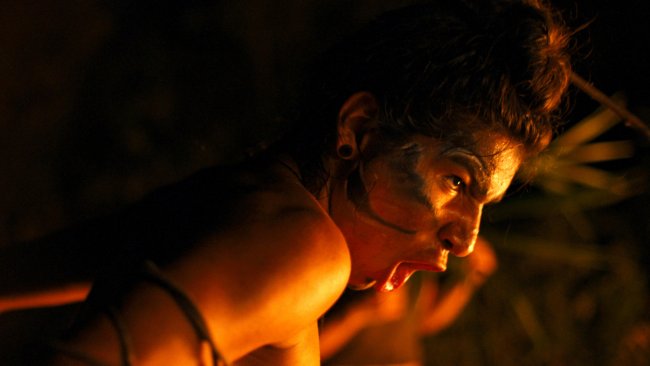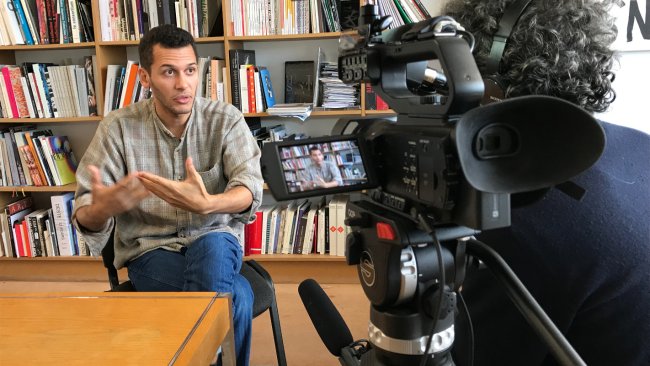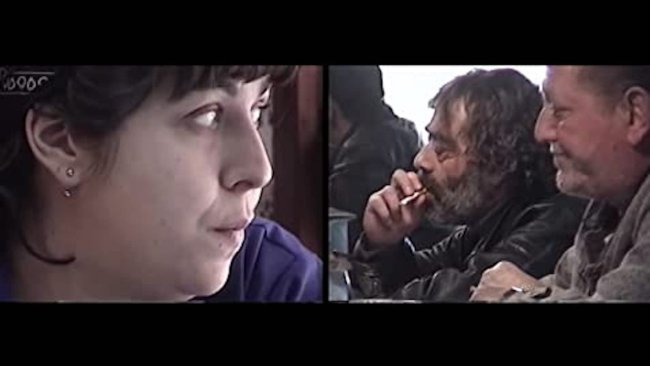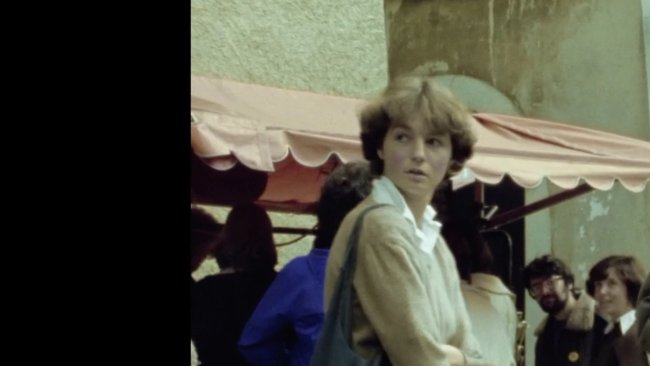Dreams from the Outback
[…] A white woman living in a busy Australian city just like the one with shiny architecture consuming Splidsboel’s opening frames, far from the remoteness of Halls Creek, wonders how we could lose these children at such a high rate. To boredom? To their insistence upon the fact that «no one gives a fuck»?
[…] Like Gabriel, Felicity mourns the reality that those who need to teach are absent in the community. She says the elders do not want to share and are «taking it to their graves»; their connection to country, language and succession eroded by two centuries of dispossession.

JODIE MCNEILLY-RENAUDIE:
Jannik Splidsboel’s film Dreams from the Outback opens with a fact: Up until 1967, Aboriginal and Torres Strait Islander people were not recognised as part of the population but categorised alongside wildlife, flora and fauna. The camera intimately enters the lives of Gabriel, Felicity and Billy living in one of Australia’s most breathtaking places, the Kimberleys, ending with the postscript: «those who lost dreaming are lost». As the film’s title suggests, we are turned towards those who dream to rediscover their culture.
Gabriel and his friend hunt kangaroos in a jovial scene of hit and miss. Unable to hit any of these bouncing roos from their 4-wheel drive, the animals smile back incredulously - no dinner from their hunt tonight, only a packet of two-minute noodles. A question mark hovers over these men’s efforts to sustain a traditional way of life. It echoes Dutch film maker Rolf de Heer’s (Northern Europeans strangely dominate recent film making of Australia’s Indigenous peoples) award winning fictional work Charlie’s Country from 2014, where Charlie (David Gulpilil) returns to the bush to live a traditional existence only to find himself hungry and near-death after a short time. Could these millennia old practices be lost in a mere 200 years? For Indigenous peoples, until they find their way in their own way, the genocide continues.
Gabriel, a Gija man, sings the land in Wangka language telling us that he will «never forget this country», a real possibility if something is not actively done to save their culture. As he ages, he realises that the older generations and elders are not helping to preserve their traditions because of booze, and nor are they permitting the younger generations (lost to booze, drugs, incarceration and suicide) from carrying them on. One such tradition is the Joonba, a performance driven by narrative, that we along with some uninvited tourists – who «don’t even pay» - are privy to. It is a moment, like other moments in the film, where it feels the camera’s eyes should not be observing. The performance is awkward and the audience is small, but there is a positivity derived of hope amongst those who participate.
Felicity, a mother of four and married to a white Australian, has had her troubles with alcohol. Now free of this debilitating illness for 14 years, she attempts to preserve culture within her family unit and the community of Halls Creek. We learn through conversation with her children what happens to the youth in their town. Suicide is a readily acceptable phenomenon. «It’s so normal»; everybody has lost someone. Billy, a vibrant and happy teen, takes us to the cemetery where his sister is buried. He found her hanging out back. A statistic now given a face and a family. His, along with Felicity’s children’s intelligence and vitality is alarming. A white woman living in a busy Australian city just like the one with shiny architecture consuming Splidsboel’s opening frames, far from the remoteness of Halls Creek, wonders how we could lose these children at such a high rate. To boredom? To their insistence upon the fact that «no one gives a fuck»?
Splidsboel incorporates hand-held video shot by Felicity’s eldest daughter Olive when she was younger. Olive excitedly shows us her world: family members, toys, a chicken, the sun. The out-of-focus images blur and collide haphazardly into one another: the erratic attentions of a child imbued with crazed fascination. Hazy in the edit are snippets of footage, stitching moments of the family together, a necessary and inviolable thread in the fabric and survival of these remote lives. Olive tells her mother that some Indigenous children «should be stolen» because their parents are just drunks. Felicity gently diffuses this opinion and says that they need to be shown how to be parents. An episteme not found in “how to parent” books, or the mitigating systems of welfare; it is a cultural transmission and takes time. The invasion (hopefully) only an interruption, not extinction. Like Gabriel, Felicity mourns the reality that those who need to teach are absent in the community. She says the elders do not want to share and are «taking it to their graves»; their connection to country, language and succession eroded by two centuries of dispossession.
The music of Bach is played over aerial shots of desert and gorge. It has a distancing effect: jarring and superficial, reminding us that we can never know Country, dreaming, or song lines like this land’s Indigenous. It alerts us to the sad possibility that those of the recent past (now buried in Christian like ways in large cemeteries) and the communities of the future are flying topographically detached and songless with the rest of us over their ancestors.
While Dreams from the Outback understandably erases white men and women from its story telling in a hands-off gesture in order to have it driven by the lives on screen, this erasure arguably goes too far. Especially when it makes the presence of one of only two white men (Felicity’s counsellor) the symbol of great white hope: her saviour from alcoholism. Not disputing his goodness or expertise, there are complex layers and information missing in this non-interrogative form of documentary making, begging the question: whom is this film for?
If it’s for non-Australian audiences, then its concentrated, synchronically sliced attention fails to shine a light on non-Indigenous responsibility and the reasons behind the problems that are conveyed. A fairly important follow up fact to 1967 is the pursuit for constitutional reform, not just symbolic recognition. It is missing in the film, demonstrating a major imbalance since Splidsboel does provide political context in the opening frame. Reform and not recognition is outlined in the 2017 Uluru Statement from the Heart, a major step in this country’s process of reconciliation that calls to enshrine first-peoples’ sovereignty that was never ceded, and a necessary rewriting of Australian history. Issues cannot be passed over by a partial representation, especially when the eyes of the world are invited to look at these lives.
If the film is for those who know about the fate of the dispossessed in colonised lands and do not need further recounting, then it would be inconsistent to generalise about the individual’s plight from such a totalising view: what is true of A must be explainable to B. Even though there is specificity in selecting one community and a few people willing to be filmed, its subtle approach does not point the finger harshly or systematically enough and makes visible only what we are made to see. Nonetheless, Splidsboel’s filming is unobtrusive and sensitive to those on screen, never gratuitously prioritising the abundant beauty of the Kimberley landscape at the expense of his subjects. His careful attention allows us to be drawn to each and every person, feeling warmed and humoured by their presence on screen. For this he has represented their individual stories with strong integrity.
*
GIUSEPPE DI SALVATORE:
Coming out from the first screening of Jannik Splidsboel’s Dreams from the Outback at the Visions du Réel festival in Nyon, I was deeply inspired by a film of immersion, a film that tries to assume, or interpret,– and here is probably the main point to be discussed – the point of view of Australia’s Indigenous people. Perhaps accustomed to the vision of documentary films, I saw in this “internal”, and sometimes suffocating journey, not only the coherence of not condescending the representation of nature and the landscape, which is in a way erased from the perception of these people, but also a universal story of isolation and ghettoization that speaks of many other indigenous peoples. The absence of confrontation with white colonisers appeared to me as a faithful expression of a specific situation, one where there is no longer a clear distinction of victims and perpetrators, as the perpetrators have been so skilled in turning their victims into the perpetrators. This perverse situation no longer speaks the language of discrimination, but the “free” choice for alcohol, drugs, depression and suicide. The lost bond to one’s own culture and country cannot be saved through a reanimation of folklore – this is eminently clear in the first of the three portraits in Dreams from the Outback, the one of Gabriel, but the sequence of portraits appears to draw a (weak) line of hope, insofar as the “step” of consciousness and despair together, embodied by Felicity, is followed by the “new” step of the brotherhood between Billy and Jordan: here the cultural clash appears to find a humanist way out, which is inescapably hybrid in terms of identity. An identity that has to be reinvented, stopping to look back towards the past.
From this perspective (and I write from Europe…), the analysis of the film by Jodie McNeilly-Renaudie, an Australian white woman, has been a real challenge for me. Through her text, I discovered that the wounds of the genocide, and the legitimate guilt of the white people, are too deep to accept that a Danish filmmaker could venture into the impossible task of assuming the point of view of the indigenous people. He should have informed and reported much more on the situation, involving the open responsibilities of the white people. I cannot criticise this position but I accept it as the expression of a reality that is unknown to me, and yet, this position seems to prevent any consideration of the situation other than in terms of victims and perpetrators, of compensation or restitution. Is it a position that allows us to understand and face up to the true meaning of lost identities? Is it a position that allows us to empathise with the indigenous peoples without projecting onto them the stigma of being victims? Is the external perspective necessarily naïve in trying to assume the point of view of the indigenous people? Is the “non-interrogative form of documentary filmmaking” necessarily missing the point in situations where injustice still reigns? Or could a naïvely empathetic attitude be considered as an interesting starting point to understanding the situation in its specific perversity?
*
JODIE MCNEILLY-RENAUDIE:
While the non-interrogative approach of the filmmaker does suggest a means for neutralising the distinction between victim and perpetrator and the reinforced stigmatisation of this very relation in post-colonialist discourse, there is something paternalistic in controlling the means for indigenous stories to be told through the privilege of white people. While generous in intent, this undertaking unfortunately highlights the inequality for a majority of Aboriginal and Torres Strait Islanders within Australian society and its main cultural fields. This is not to say that indigenous filmmakers do not exist. Those artists who should at all costs be enabled to tell this story and other stories like the incremental rise of an educated, middle-class indigenous: a phenomenon that Dreams from the Outback cannot consider because of the profiles chosen. Our empowered indigenous gain their lives through little help from the system that has pledged to ‘close the gap’ in all areas of life, but fails dismally because there is no genuine listening. The “perpetrators” of colonisation throw money at communities, but it does not heal the wounds of mass genocide, stolen children and land, high rates of infant mortality, incarceration, deaths in custody, suicide… the list goes on. A symbolic “sorry” doesn’t cut it either.
Understandably, the filmmaker wanted to tell these particular stories with a hands-off approach, a gesture that is respectful to those whose stories are told, but problematic for understanding the greater context and needs of indigenous in this country. To mitigate the distinction between victim and perpetrator is problematic. That the filmmaker helps us see how “the perpetrators have been so skilled in turning their victims into the perpetrators”, annihilating their own culture as a result of long-worn apathy, unintentionally participates in the disempowering processes of civilising that started with the invasion. Frantz Fanon was described by his biographer David Macey as appositely angry. Empathy, in the Australian case, undermines the kind of directed anger that is needed to give Fanon’s “wretched of the earth” (our colonised peoples) hope. Perhaps when they share power through irrevocable constitutional reform we can see it in another way.
This article contains a third-party video. If you would like to watch the video, please adjust your settings.
Info
Dreams from the Outback | Film | Jannik Splidsboel | DK 2019 | 79’ | Visions du Réel Nyon 2019
First published: April 25, 2019



